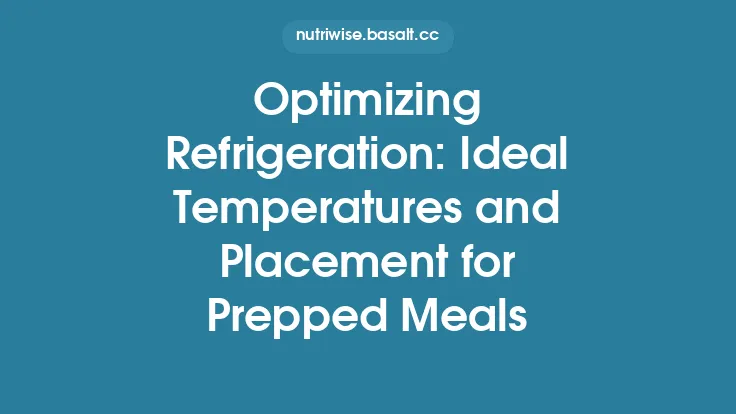When you set aside a batch of cooked quinoa, a pot of chili, or a tray of roasted vegetables, the next question that usually pops up is: *how long will this actually stay good?* Understanding shelf life isn’t just about avoiding waste—it’s also about preserving the flavors, textures, and nutritional value you worked hard to build into each meal. Below, we break down the science behind shelf life, the variables that push it one way or the other, and practical guidelines for the most common types of pre‑prepared dishes. Armed with this knowledge, you’ll be able to plan your cooking schedule with confidence, knowing exactly when a meal is still at its prime and when it’s time to let it go.
What “Shelf Life” Really Means
Shelf life is the period during which a food product remains acceptable for consumption under defined storage conditions. It is not a fixed number; rather, it is a range that reflects how quickly chemical, physical, and biological changes occur. In the context of meal prep, shelf life answers three core questions:
- Safety – When does the food become a potential health risk?
- Quality – When do taste, texture, or appearance start to deteriorate?
- Nutrient Retention – When do vitamins, antioxidants, and other beneficial compounds begin to break down?
While safety is the non‑negotiable baseline, most home cooks are primarily concerned with quality and nutrient retention, because those are the factors that dictate whether a meal still feels “fresh” and enjoyable.
The Main Drivers of Shelf Life
| Factor | How It Affects Shelf Life | Practical Takeaway |
|---|---|---|
| Temperature | Higher temperatures accelerate microbial growth and chemical reactions (e.g., oxidation). | Keep meals consistently cold (refrigerated) or frozen; avoid frequent temperature swings. |
| Moisture Content | Water activity (aw) is a key predictor of microbial activity. Drier foods last longer; high‑moisture dishes spoil faster. | Pat dry excess sauce or broth before storage; consider separating wet and dry components. |
| pH (Acidity) | Low pH (acidic) environments inhibit many spoilage organisms, extending shelf life. | Incorporate acidic ingredients (vinegar, citrus) where appropriate to naturally lengthen freshness. |
| Oxygen Exposure | Oxygen fuels oxidation of fats and pigments, leading to rancidity and color loss. | Store in airtight containers (but not the focus of this article) and limit headspace. |
| Ingredient Composition | Fats, proteins, and sugars each have distinct degradation pathways. Fatty foods oxidize; proteins can denature; sugars may ferment. | Recognize which component dominates a dish and adjust expectations accordingly. |
| Processing & Cooking Method | High‑heat cooking can reduce microbial load but also create more reactive compounds that speed up spoilage. | Gentle cooking methods (steaming, poaching) often yield a longer‑lasting product than deep‑frying. |
| Additives & Preservatives | Natural acids, salts, and spices can act as mild preservatives. | Use herbs like rosemary or spices like garlic, which have antimicrobial properties, to modestly extend life. |
Understanding how each of these variables interacts helps you predict the lifespan of a specific meal, rather than relying on a one‑size‑fits‑all rule.
General Shelf‑Life Benchmarks for Common Meal‑Prep Categories
Below are evidence‑based ranges for how long typical pre‑cooked foods stay at their best when stored under normal home refrigeration (≈4 °C) or standard freezer conditions (≈‑18 °C). These are *quality* windows; safety should always be assessed by checking for off‑odors, slime, or visible mold.
| Food Type | Refrigerator (Days) | Freezer (Weeks) | Key Quality‑Loss Indicators |
|---|---|---|---|
| Cooked lean proteins (chicken breast, turkey, fish) | 3‑4 | 2‑3 | Dryness, loss of juiciness, mild sour smell |
| Cooked fatty proteins (ground beef, pork shoulder) | 3‑4 | 2‑3 | Slight greasiness, off‑odor, discoloration |
| Legumes & beans (cooked) | 4‑5 | 2‑3 | Softening beyond desired texture, sour aroma |
| Whole grains (rice, quinoa, farro) | 4‑5 | 2‑3 | Hardening, stale taste, slight off‑smell |
| Stir‑fry vegetables (mixed, lightly cooked) | 3‑4 | 2‑3 | Loss of crunch, wilting, discoloration |
| Roasted root vegetables (sweet potatoes, carrots) | 4‑5 | 2‑3 | Moisture loss, mushy interior |
| Soups & stews (broth‑based) | 3‑4 | 2‑3 | Separation of fat, sour smell, cloudiness |
| Sauces & dressings (oil‑based) | 5‑7 | 2‑3 | Rancidity, separation, off‑taste |
| Salads with fresh greens (no dressing) | 1‑2 | — | Wilting, slime, yellowing |
| Salads with dressing mixed in | 1‑2 | — | Soggy leaves, off‑odor, discoloration |
| Egg‑based dishes (quiche, frittata) | 3‑4 | 2‑3 | Rubberiness, sour smell |
| Dairy‑rich dishes (mac & cheese, creamy casseroles) | 3‑4 | 2‑3 | Separation, sour odor, grainy texture |
Why the ranges differ:
- Protein type influences how quickly enzymes break down muscle fibers.
- Fat content accelerates oxidation, especially in the presence of light.
- Water‑rich vegetables wilt faster because cell walls collapse when moisture is lost.
- Acidic soups (tomato‑based) often last a day longer than neutral broths due to lower pH.
Refrigerator vs. Freezer: How the Same Meal Behaves Differently
| Aspect | Refrigerator | Freezer |
|---|---|---|
| Primary degradation | Microbial growth, enzymatic activity, oxidation | Ice crystal formation, freezer burn, slow enzymatic activity |
| Texture changes | Softening, loss of crispness | Potential graininess (especially in high‑water foods) after thawing |
| Flavor evolution | Mild flavor development (e.g., soups may taste richer) | Possible muted flavors; some spices become less pronounced |
| Nutrient stability | Vitamin C and some B‑vitamins degrade faster | Most nutrients remain stable; however, prolonged freezing can affect texture of vitamins like vitamin A in fatty foods |
Key point: Even though the freezer dramatically slows down spoilage, it does not halt it entirely. Ice crystals can puncture cell walls, leading to a mushier texture once the food is thawed. This is why dishes with high water content (e.g., fresh salads) are generally not freezer‑friendly, while dense stews and baked casseroles fare better.
How Cooking Methods Shape Shelf Life
- High‑Heat Roasting / Baking
- Effect: Reduces surface moisture, creating a protective crust that can delay microbial invasion.
- Trade‑off: The Maillard reaction creates reactive compounds that may accelerate oxidation of fats on the surface.
- Steaming / Poaching
- Effect: Retains moisture, which can be a double‑edged sword: it keeps foods tender but also maintains a higher water activity, encouraging faster microbial growth if not cooled quickly.
- Sautéing / Stir‑Frying
- Effect: Quick, high‑heat exposure reduces overall cooking time, limiting the period microbes have to multiply. However, the oil used can become a site for oxidation, especially if the oil is reused.
- Slow‑Cooking / Braising
- Effect: Long, low‑temperature cooking can break down connective tissue, making proteins more tender, but the extended exposure to heat can also degrade heat‑sensitive nutrients (e.g., vitamin C).
- Grilling / Charbroiling
- Effect: Direct flame creates a char layer that can act as a barrier, but the char itself may harbor compounds that accelerate off‑flavors over time.
Practical tip: When planning a week’s worth of meals, consider pairing a high‑heat method (roasting) for items you intend to eat later in the week with a low‑heat method (steaming) for meals you’ll consume sooner. This balances texture and longevity.
Ingredient‑Level Strategies to Nudge Shelf Life Longer
- Acidic Boosters: Adding a splash of lemon juice, lime, or a modest amount of vinegar can lower pH enough to slow bacterial growth without dramatically altering flavor.
- Salt & Sugar: Both act as osmotic agents, drawing water out of microbial cells. A modest increase (e.g., a teaspoon of salt in a grain bowl) can extend freshness by a day or two.
- Herbs & Spices: Certain compounds—like allicin in garlic, eugenol in clove, and rosmarinic acid in rosemary—have mild antimicrobial properties. Including them in sauces or marinades can provide a natural shelf‑life boost.
- Fat Type: Saturated fats (e.g., coconut oil) are more resistant to oxidation than polyunsaturated fats (e.g., flaxseed oil). If a dish relies heavily on oil, choosing a more stable fat can delay rancidity.
Predicting Shelf Life: A Simple “Four‑Factor” Check
When you finish cooking, ask yourself these four quick questions to estimate how long the meal will stay at its best:
- Moisture Level: Is the dish wet, dry, or somewhere in between? Drier dishes (roasted nuts, baked grains) generally last longer.
- Acidity: Does the recipe include tomatoes, citrus, or fermented components? Higher acidity = longer shelf life.
- Fat Content: Is the meal high in oils or butter? More fat = higher risk of oxidation, especially if stored in the fridge.
- Protein Type: Lean vs. fatty protein? Lean proteins (chicken breast) tend to stay fresh a bit longer than fatty cuts (ground pork).
If the answer leans toward “dry, acidic, low‑fat, lean protein,” you can comfortably aim for the upper end of the time ranges listed earlier. Conversely, a wet, neutral‑pH, high‑fat, fatty‑protein dish should be consumed nearer the lower end.
Spotting the Subtle Signs of Decline
Even with careful planning, foods can surprise you. Here are the most reliable visual, olfactory, and tactile cues that a prepped meal is past its prime:
- Color Shift: Greens turning brown, sauces developing a grayish hue, or meat developing a dull pink.
- Surface Film: A thin, whitish or gray film on the surface of soups, stews, or sauces often signals microbial growth.
- Off‑Odor: A sour, yeasty, or “off” smell that wasn’t present when the dish was fresh.
- Texture Change: Vegetables that become excessively mushy, grains that feel gummy, or proteins that develop a rubbery coating.
- Mold Spots: Any visible fuzzy growth, regardless of color, is a clear indicator to discard.
When in doubt, trust your senses. If a dish looks, smells, or feels off, it’s safer to err on the side of caution.
Planning Your Prep Cycle Around Shelf Life
Knowing the typical lifespan of each dish lets you design a prep schedule that minimizes waste:
- Weekly Rotation: Cook a core set of staples (e.g., quinoa, roasted chicken, steamed broccoli) that each have a 3‑5‑day refrigerator window. Use them in different combinations across the week to keep meals varied.
- Bi‑Weekly Freezer Stock: For meals that comfortably sit in the freezer for 2‑3 weeks (soups, stews, baked casseroles), batch‑cook larger quantities and freeze in portion‑sized blocks. Thaw only what you need for the upcoming 3‑4 days.
- Mid‑Week Refresh: On day 4 or 5, prepare a “fresh‑add” batch—quickly sautéed greens, a fresh salsa, or a boiled egg—to rejuvenate older base meals and restore texture contrast.
By aligning cooking frequency with the natural decay curve of each food group, you keep flavors bright, textures appealing, and your grocery bill lean.
Bottom Line
Shelf life is a dynamic balance of chemistry, biology, and the choices you make in the kitchen. While no single rule can predict the exact moment a meal will turn undesirable, understanding the core drivers—temperature, moisture, pH, oxygen, and ingredient composition—gives you a reliable framework for planning. Use the benchmark tables as a starting point, apply the four‑factor check to each new recipe, and stay vigilant for visual or olfactory red flags. With this approach, you’ll be able to prep confidently, eat deliciously, and waste far less of the food you love.





